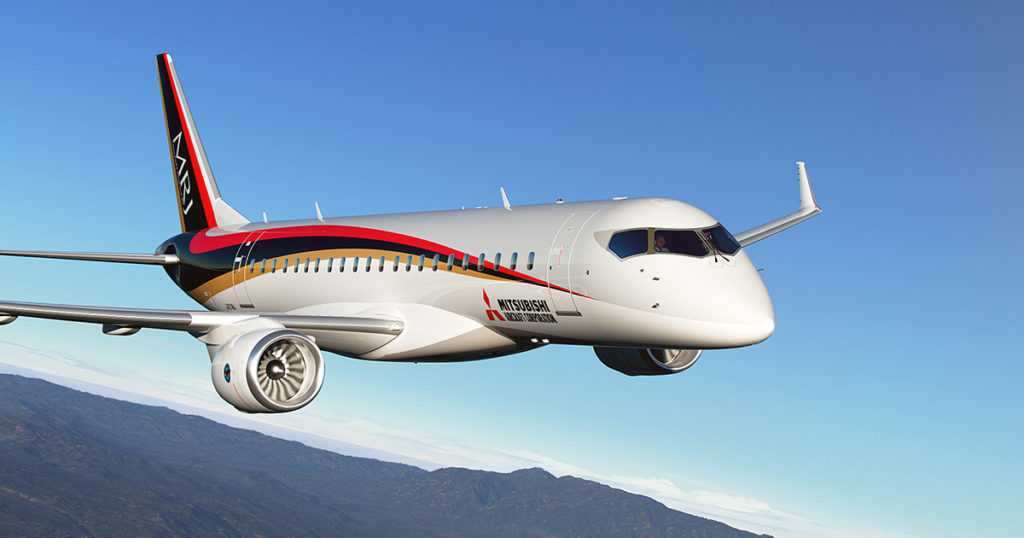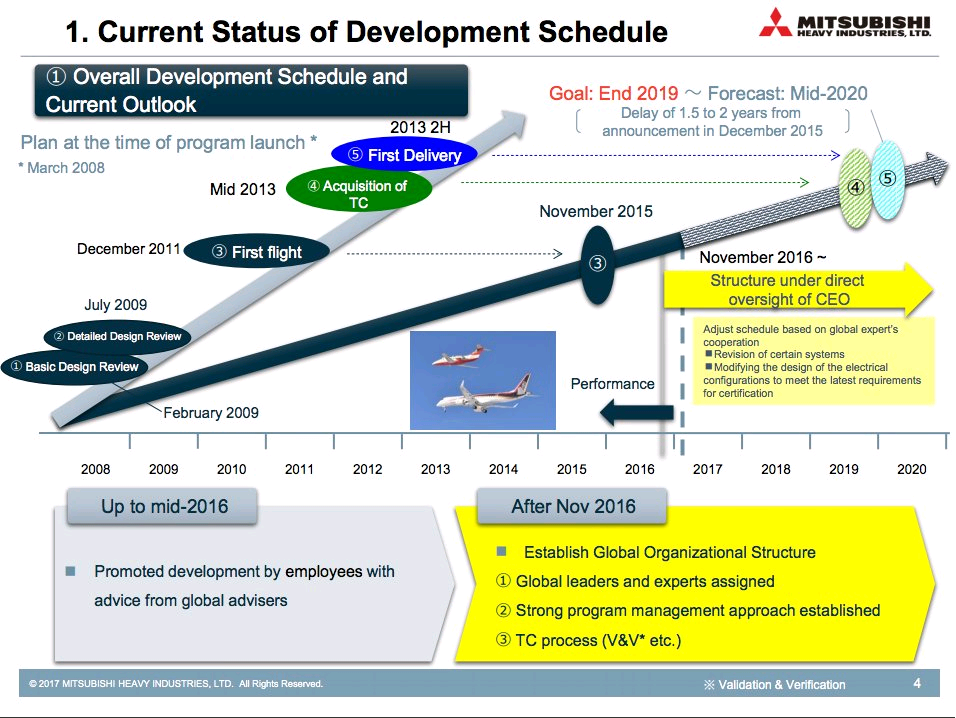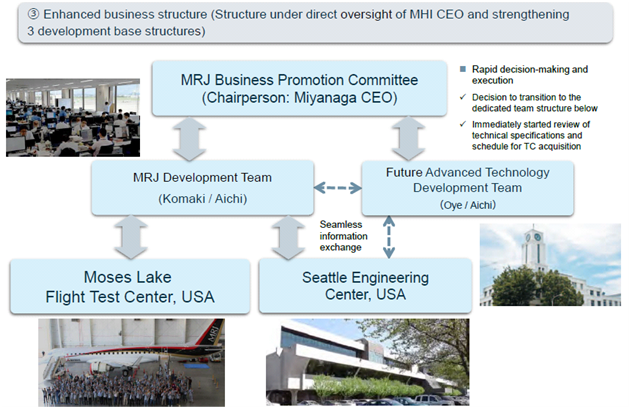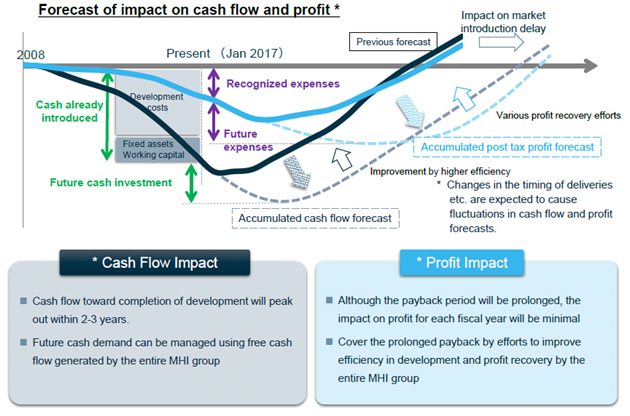Leeham News and Analysis
There's more to real news than a news release.
MRJ regional jet delayed until mid-2020
By Bjorn Fehrm
January 23, 2017, ©. Leeham Co: Mitsubishi announced a further two years delay of the MRJ regional jet project in a press conference in Tokyo today.
The 90-seater variant of the aircraft will be delivered to the first customer, All Nippon Airways (ANA), mid-2020.
The previous scheduled Entry Into Service (EIS) of mid 2018, was announced December 2015. In total, the MRJ program has announced five delays, totaling seven years.
MRJ program schedules
The MRJ program kicked off 2008. The goal was to put Japan back on the world’s civil aircraft scene. The original schedule had certification and EIS in 2013, Figure 1. This schedule is now revised for the fifth time to a mid-2020 EIS. The announcement was made by the parent company of Mitsubishi Aircraft Corporation (MAC), Mitsubishi Heavy Industries (MHI).
The new schedule is six years (goal according to MHI) or seven years longer (Forecast according to MHI) than the first plan. To give two delivery times as in Figure 1 is unusual, however the difference is seven months on a 12 year development program.
What has gone wrong
With five delays on a program that should span six years (March 2008 to end 2013) and in the end takes 12, one wonders what has gone so terribly wrong. MHI is as candid about the cause of the delays as it is with the schedule in Figure 1.
The aircraft development started with a Japanese team and this team did not have the expertise needed to understand all the implications of modern certification requirements, Figure 2.
As the Seattle development center and the Moses Lake test center came online, experienced engineers coming from, e.g. Boeing, got insight into the program. The Western workforce started finding oversights in the work of the Japanese team.
The first conclusion of the reviews these teams made was the test program was not realistic. It was based on how aircraft were tested and certified historically. You fly and measure and then decide if things are OK.
This is not how tests are done today. You prepare the test thoroughly, you simulate the test results in a ground environment and you only fly when the ground tests show that you can have a fault-free test flight. Test flights are made to verify results, not to explore developments.
As the international engineering team dived deeper into the design of the MRJ, it found more issues. The MHI press release states that the project needs “revisions of certain systems and electrical configurations on the aircraft to meet the latest requirements for certification.”
LNC understands the Western experts found issues with system redundancy in the aircraft. This now requires redesign of parts of the avionics and electrical setup of the aircraft.
The present aircraft can be safely test flown to verify performance and certify flight characteristics, but the aircraft’s redundancy concept cannot be certified as is, Figure 3.
MHI and its marketing and development arm for the aircraft, Mitsubishi Aircraft Corporation, announced organizational changes as a result of the oversights, Figure 4.
What was previously a Japanese development organization at MAC that took advice from the Seattle/Moses Lake teams will now be an MHI lead program.
The different engineering and management groups will report to the MHI CEO via an MRJ management and a Future Advanced Technology team. Any developments will have the direct involvement of Western experts, both in the decisions around the present program and future aircraft program developments.
Summary
The delays prolong the work of an increasingly large development organization. The cash flow impact is shown in Figure 5. The large MHI group will absorb the increased costs.
The forecast implies that MAC would keep its present customer base. We think this is wishful thinking. A total of 150 of the present 223 firm orders are from US regional operators which are operating under US carrier scope clauses (see this article).
It will be increasingly difficult to keep these customers. The delays and scope clauses will probably force these operators to source their aircraft needs from other manufacturers, at least for the shorter term.
There are no signs of the MRJ losing operating performance through the delays but the availability of aircraft has now slipped a least five years from the original plan. The need for operational capacity from regional aircraft in the US market has not slipped.







Would it be possible to use the 3years to quickly bang in a mrj 86 to lose the 600kg? I suppose there is a slight risk that by the time it’s ready, the scope clause changes.
The Japanese are famed for their efficiency, this balls up illustrates how high the barriers to entry are even for a nation of engineers in an age of global knowledge
“…this balls up illustrates how high the barriers to entry are even for a nation of engineers in an age of global knowledge…” Exactly what I was seeing in this piece.
Nice to see a major corporation being so candid, instead of spewing carefully crafted propaganda.
This article shows how onerous the certification process has become, to the point where you have to wonder: why would anyone want to develop a new product to compete with the few existing RJs? Of course we need rigor in certification processes, but that rigor should not effectively be establishment protectionism.
I’ll go out on a limb here and say this plane is dead. It might make a comeback later in some other form in the 20’s
I think this has nothing to do with protectionism. They were designing a Part 25 airliner, which carry 100 people as it was a small general aviation aircraft. The current requirements are strict, but they are like that for everybody. How can you design an aircraft of this category not considering the most notable requirement for airborne systems: a catastrophic event must not occur from a single failure?
Exactly, I don’t think there is any excuse for what Mitsubishi did except they were arrogant and hard-headed. Same with Honda and their Honda-Jet.
A different route was taken by Sukhoi and Saturn for the SuperJet. Very early on, Sukhoi hired Boeing advisors and Saturn teamed with SNECMA to build the engines. As a result, there not all the certification heartaches involved, and now that Saturn and Sukhoi know the process, they can go it alone from here on out.
Same thing with the Honda F1 engine arrogant and pig headed,failed to take advice.But they are are good engineer’s and don’t give up easily.
I was one of the sceptics last year, but they seemed to talk Bjorn around.
Right up until this last announcement they were releasing positive statements.No one can rely on delivery of this plane ever happening.
@Grubbie,
This is not the first time I’ve seen Japanese Design and Engineering Management do a Face Plant. I worked with a technically-brilliant team of Japanese Engineers on a Telecom project that fell flat because the Japanese were so hard-headed about trying to understand American Telecom certification requirements. From start to finish, the project was a $300 Million Dollar debacle.
Until the Japanese learn how to listen and take advice from their western counterparts, they’re gonna’ keep blowing money for nothing trying to enter Western Markets where there is a lot of red-tape that insures product safety and compatibility. That’s why ya’ don’t see many Japanese Medical Devices, Aeroplanes or Telecom Equipment on the market.
The test fleet will look nice in 3-4 aviation museums.
The other Japanese airframe manufacturer Kawasaki has stuck to military designs and has done quite well with two completely new different planes for maritime patrol (P-1)and cargo delivery( C-2). Mitsubishi has had its own military development of improved western fighter designs ( F1 and F2) and its protoype X-2 Shinshin stealth jet( roughly comparable to the F-35- or what that plane should have been!)
I’d wonder if Kawasaki should have taken up the passenger jet project, while the certification would be different, the challenges are more similar with its existing projects.
Mitsubishi’s partner on the MRJ is Toyota which is through its affiliate Subaru Corp ( its aviation division was previously known as Fuji)
The civilian market seems an arena much more competitive than the military. Also, I think civil certification requires far better planning and documentation. It may be easier to develop a larger commercial plane from a modern (but humble) turboprop than from an advanced military aircraft. China, Russia and Japan do not shown in commercial airplanes the expected strengh.
I was thinking Kawasaki’s larger airframe projects were more compatible to a civilian airliner to Mitsubishi’s fast fighter types. Ill bet this will be MJRs only project so the certification knowledge wont we kept current. A repeat of the last Japanese airliner.
As for Kawasaki’s existing planes are a 4 engined maritime patrol which is roughly the same size as the P-8 derived from the 737-800 and the C-2 military transport which is just a bit smaller overall than the 767 derived KC-46 ( but with a much larger diameter fuselage of course)
Kawasaki had hoped to get civil certification for its C2 transport, to allow much wider use, much like the Hercules did with their older and more recent C130J versions.
Thats been dropped now, no doubt from the feedback over Mitsubishi’s problems.